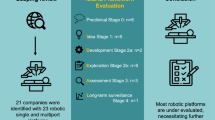Abstract
Laparoscopic urology has gained considerable popularity since the first laparoscopic nephrectomy was performed. However, the rapid application of the technique in urologic practice has led to increased reports of complications, even in the hands of surgeons who are well experienced in open surgical techniques, often early in a surgeon’s laparoscopic experience. The lack of translation of open surgical skills into laparoscopic results has led us to reappraise the learning curves relevant to open and laparoscopic surgery, to understand the differences, and enable us to make changes in the curriculum and the training to acquire laparoscopic skills.
Similar content being viewed by others
References and Recommended Reading
Emken JL, McDougall EM, Clayman RV: Training and assessment of laparoscopic skills. JSLS 2004, 8:195–199. An overview of the present status of teaching laparoscopic skills, assessment of such skills, and incorporation of laparoscopic curricula into surgical training programs.
Clayman RV, Kavoussi LR, Soper NJ, et al.: Laparoscopic nephrectomy: initial case report. J Urol 1991, 146:278–282.
Fahlenkamp D, Rassweiler J, Fornara P, et al.: Complications of laparoscopic procedures in urology: experience with 2407 procedures at four German centers. J Urol 1999, 162:765–770.
Suzuki K, Ushiyama T, Kageyama S, et al.: Laparoscopic adrenalectomy-transperitoneal versus retroperitoneal approach [Abstract 590]. J Urol 1998, 159:155.
Simon SD, Castle EP, Ferrigni RG, et al.: Complications of laparoscopic nephrectomy: the Mayo clinic experience. J Urol 2004, 171:1447–1450.
Meraney AM, Samee AA, Gill IS: Vascular and bowel complications during retroperitoneal laparoscopic surgery. J Urol 2002, 168:1941–1944.
Gill IS, Kavoussi LR, Clayman RV, et al.: Complications of laparoscopic nephrectomy in 185 patients: a multi-institutional review. J Urol 1995, 154:479–483.
Parsons JK, Varkarakis I, Rha KH, et al.: Complications of abdominal urologic laparoscopy: longitudinal 5-year analysis. Urology 2004, 63:27–32.
Bhayani SB, Pavlovich CP, Strup SE, et al.: Laparoscopic radical prostatectomy: a multi-institutional study of conversion to open surgery. Urology 2004, 63:99–102.
Vallancien G, Cathelineau X, Baumert H, et al.: Complications of transperitoneal laparoscopic surgery in urology: review of 1311 procedures at a single center. J Urol 2002, 168:23–26.
Figert PL, Park AE, Witzke DB, et al.: Transfer of training in acquiring laparoscopic skills. J Am Coll Surg 2001, 193:533–537.
Rosenberg BH, Landsittel D, Averch TD: Can video games be used to predict or improve laparoscopic skills? J Endourol 2005, 19:372–376.
Cadeddu JA, Wolfe JS Jr, Nakada S, et al.: Complications of laparoscopic procedures after concentrated training in urological laparoscopy. J Urol 2001, 166:2109–2111.
Kneebone R: Simulation in surgical training: educational issues and practical implications. Med Educ 2003, 37:267–277.
Medina M: Formidable challenges to teaching advanced laparoscopic skills. JSLS 2001, 5:153–158.
Nakada SY, Hedican SP, Bishoff JT, et al.: Expert videotape analysis and critiquing bene.t laparoscopic skills training of urologists. JSLS 2004, 8:183–186.
Touijer K, Kuroiwa K, Saranchuk JW, et al.: Quality improvement in laparoscopic radical prostatectomy for pT2 prostate cancer: impact of video documentation review on positive surgical margin. J Urol 2005, 173:765–768.
Colegrove PM, Win.eld HN, Donovan JF Jr, et al.: Laparoscopic practice patterns among North American urologists 5 years after formal training. J Urol 1999, 161:881–886.
McDougall EM, S. L.: Surgical simulation. AUA Update Series Lesson 26 2005, 24:225–244. An excellent summary of the current status of surgical simulation, validity testing, and incorporation of simulators in surgical education.
Fried GM, Feldman LS, Vassiliou MC, et al.: Proving the value of simulation in laparoscopic surgery. Ann Surg 2004, 240:518–528.
Grantcharov TP, Kristiansen VB, Bendix J, et al.: Randomized clinical trial of virtual reality simulation for laparoscopic skills training. Br J Surg 2004, 91:146–150.
Fabrizio MD, Tuerk I, Schellhammer PF: Laparoscopic radical prostatectomy: decreasing the learning curve using a mentor initiated approach. J Urol 2003, 169:2063–2065. This study demonstrates a practical approach to introducing difficult laparoscopic procedures into a program.
Frede T, Erdogru T, Zukosky D, et al.: Comparison of training modalities for performing laparoscopic radical prostatectomy: experience with 1000 patients. J Urol 2005, 174:673–678. An important study exploring the transferability of laparoscopic skills between generations of surgeons.
Munver R, Del Pizzo JJ, Sosa RE: The advantages of handassisted laparoscopy. Curr Urol Rep 2004, 5:100–107.
Gaston KE, Moore DT, Pruthi RS: Hand-assisted laparoscopic nephrectomy: prospective evaluation of the learning curve. J Urol 2004, 171:63–67.
Nelson CP, Wolf JS Jr: Comparison of hand-assisted versus standard laparoscopic radical nephrectomy for suspected renal cell carcinoma. J Urol 2002, 167:1989–1994.
Poulakis V, Dillenburg W, Moeckel M, et al.: Laparoscopic radical prostatectomy: prospective evaluation of the learning curve. Eur Urol 2005, 47:167–175.
Ahlering TE, Skarecky D, Lee D, et al.: Successful transfer of open surgical skills to a laparoscopic environment using a robotic interface: initial experience with laparoscopic radical prostatectomy. J Urol 2003, 170:1738–1741. This study demonstrates that robotics can shorten the learning curve by transfer of open surgical skills to laparoscopy.
Author information
Authors and Affiliations
Corresponding author
Rights and permissions
About this article
Cite this article
Kumar, U., Gill, I.S. Learning curve in human laparoscopic surgery. Curr Urol Rep 7, 120–124 (2006). https://doi.org/10.1007/s11934-006-0070-5
Issue Date:
DOI: https://doi.org/10.1007/s11934-006-0070-5




